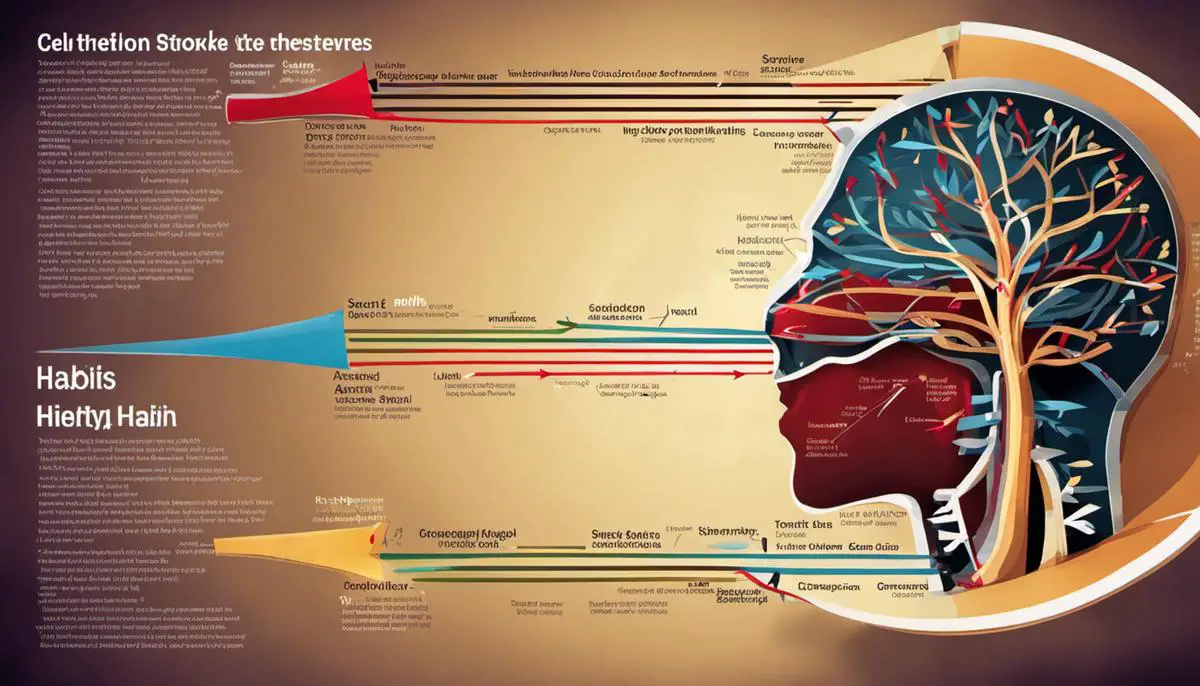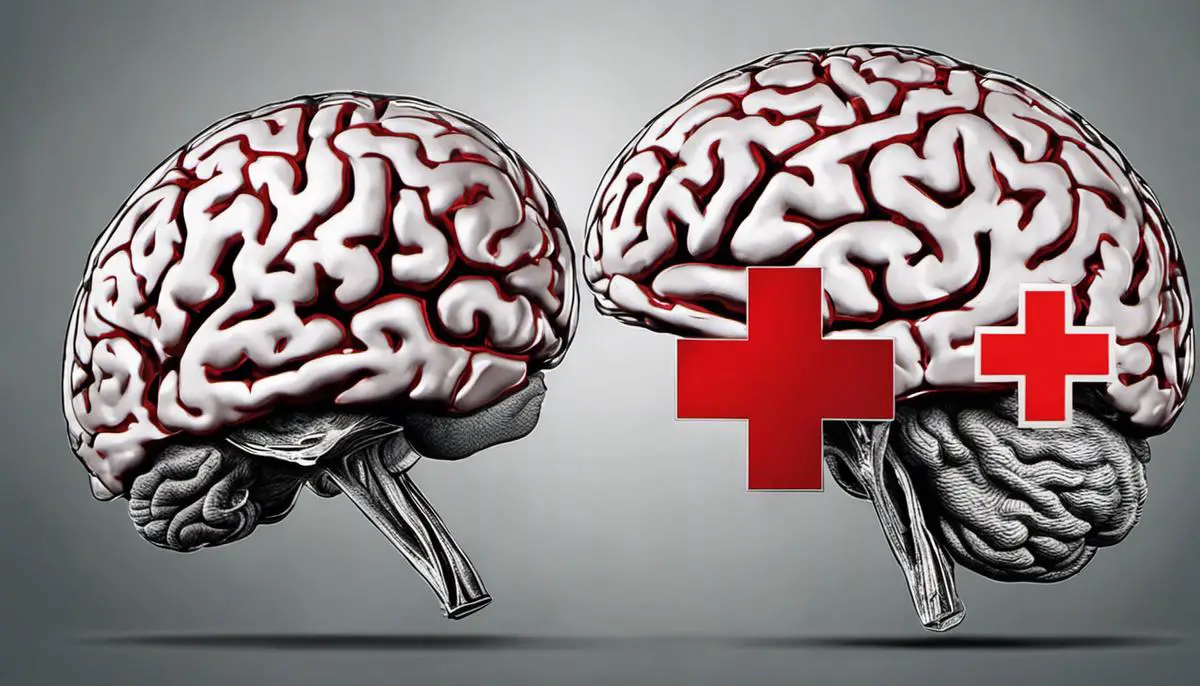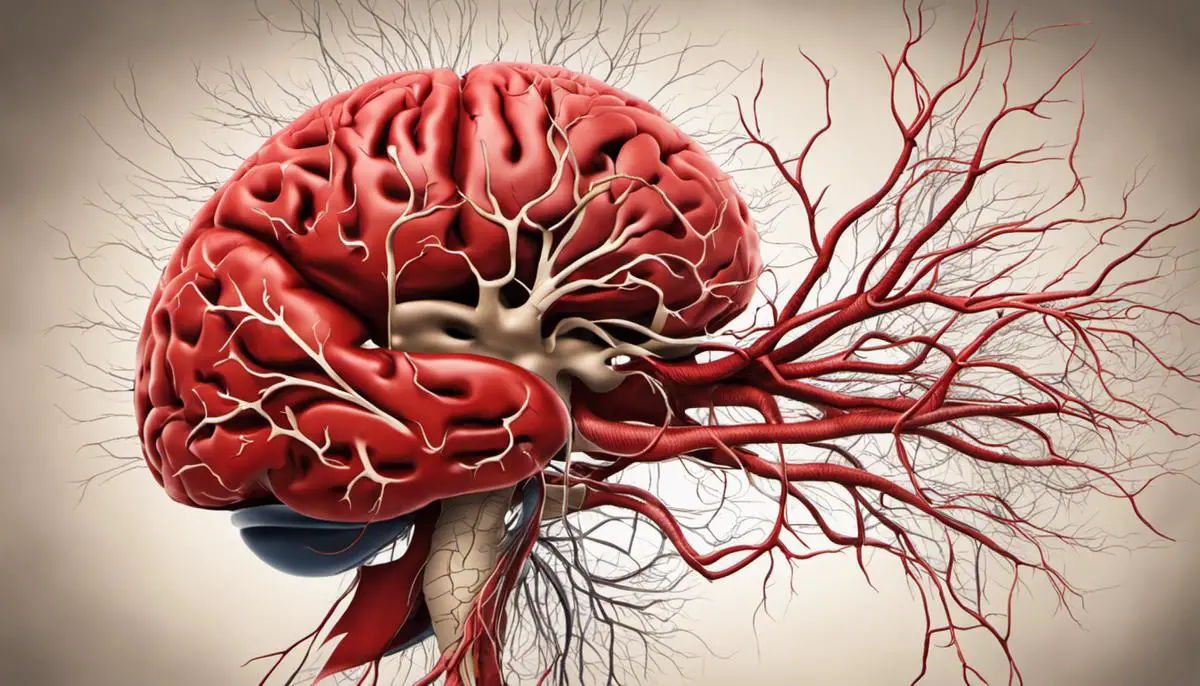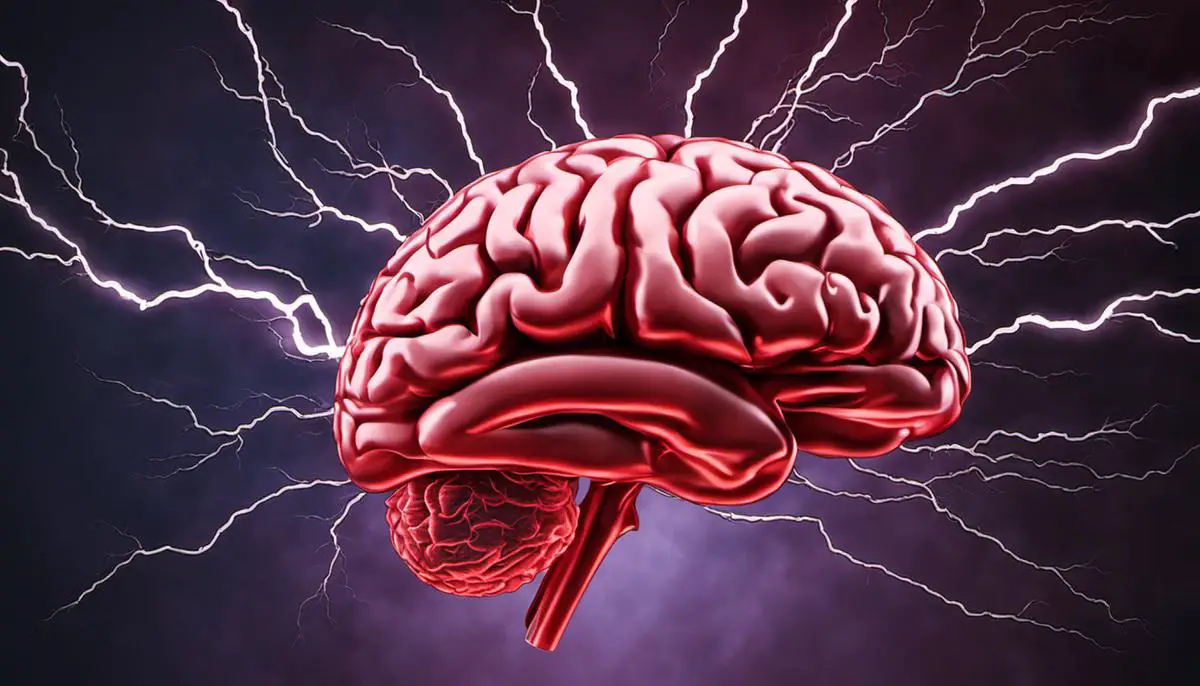Living in a world that’s constantly moving at a rapid pace, the common yet potentially dangerous phenomenon we’re often running into is — Stress. An inevitable part of modern life, stress can impact both, our psychological well-being and physical health if not addressed timely. While stress has short-term effects that are noticeable, its long-term effects are lurk beneath the surface, affecting our overall health considerably. One such significant health implication is stroke. Stroke, a medical condition caused by interrupted blood supply to the brain, manifests a range of symptoms and impacts individuals and their families in profound ways. It’s no longer hushed news that there’s a perceptible link between stress and stroke, and unlocking this connection is critical in stroke prevention efforts.
Understanding Stress
Understanding Stress: The Basics
Stress, in psychology, is perceived or actual threat to one’s physical, mental, or emotional well-being. It is the body’s reaction to any change that requires an adjustment or response. The human body is designed to experience stress and react to it. Stress can be positive or negative, depending on the situation. Positive stress helps individuals stay alert and avoid danger, while negative stress leads to long-term damage to health if not managed properly.
Stress is typically categorized into three types: acute, episodic acute, and chronic. Acute stress is the most common form and is a brief reaction to an immediate threat or challenge. Episodic acute stress occurs when people suffer acute stress frequently. Lastly, chronic stress is a continuous, long-term form of stress that can lead to significant health problems if left untreated.
The main causes of stress include major life changes, work or school, relationship difficulties, financial problems, and being too busy. Different individuals may perceive situations differently; therefore, not everyone who experiences the same stressful situation will respond in the exact same way.
Physical and Psychological Manifestations of Stress
Physically, stress can lead to headaches, upset stomach, elevated blood pressure, chest pain, and problems sleeping. It can also worsen certain pre-existing medical conditions. Psychologically, stress can bring about feelings of restlessness, irritability, anxiety, sadness, or lack of motivation and focus.
People process stress differently depending on their personal coping skills, social support, and physical health. Some may opt for healthy coping methods like exercise, meditation, and speaking to a therapist, while others might engage in unhealthy behaviors like alcohol or drug abuse, and ignoring the problem.
Short-Term and Long-Term Effects of Untreated Stress
Short-term effects of untreated stress can include nagging headaches, tension, and sleep problems. Over time, these issues can escalate and become chronic, leading to more severe health problems like heart disease, high blood pressure, diabetes, and other illnesses.
The Correlation Between Stress and Stroke
The link between stress and stroke is primarily based on the long-lasting consequences of unresolved or inconsistently treated stress. Chronic or extreme stress can often generate life patterns that surge the probability of a stroke, along with direct physiological modifications.
Highly stressful scenarios tend to induce individuals to form negative habits, like improper nutrition, sedentary lifestyle, smoking, or an increased consumption of alcohol. Such habits can lead to conditions such as high blood pressure, arterial hardening, or blood clot formation, all of which augment the risk of a stroke.
In addition, enduring stress prompts the nervous system to release excessive vasoconstricting hormones, causing a rise in blood pressure that can potentially result in a stroke.
The body under stress also generates a greater number of blood cells. Excessive blood cells can result in blood clots, another known risk for a stroke.
Given these risks, it’s crucial to effectively manage stress for stroke prevention. Adopting better lifestyle habits, developing successful stress management tools and seeking professional assistance when necessary can significantly reduce the risk of experiencing a stroke related to stress.

Stroke: What You Need to Know
What Does A Stroke Mean?
A stroke is a medical condition that happens when the blood supply to a part of the brain is interrupted or significantly reduced. As a result of this, the brain cells are deprived of the necessary oxygen and nutrients they need to function appropriately. Consequently, the affected brain cells start to die, which can instigate a variety of symptoms and potentially lead to enduring disability or even death. The impact of a stroke can fluctuate based on the specific region in the brain that’s affected and the duration of the blood supply cut-off.
Types of Stroke
There are three main types of stroke: Ischemic, Hemorrhagic, and Transient Ischemic Attacks (TIAs). Ischemic strokes, the most common type, are caused by a blockage of blood flow to the brain. Hemorrhagic strokes happen when a blood vessel within the brain bursts, causing bleeding into surrounding tissues. TIAs are often called mini-strokes because they’re a temporary disruption of blood flow to the brain, usually lasting only a few minutes.
Symptoms of a Stroke
It’s crucial to know the symptoms of a stroke which typically occur suddenly. These include confusion or difficulty understanding, trouble speaking, dizziness or loss of balance, sudden and severe headaches, difficulty seeing in one or both eyes, and sudden numbness, weakness or paralysis, particularly on one side of the body.
Causes and Risk Factors
The leading cause of stroke is high blood pressure. Other critical risk factors include smoking, diabetes, high cholesterol, obesity, and a family history of stroke or heart disease. Moreover, the chances of experiencing a stroke also increase with age, particularly for those over 55 years old.
Stress can also potentially contribute to the risk of a stroke. Though not a direct link, chronic stress can lead to behaviors and factors that increase the likelihood of a stroke including high blood pressure, smoking, physical inactivity, and heavy alcohol use.
Impact of Stroke
The implications of a stroke can be devastating both physically and emotionally, not just to the individual affected, but also to their family and friends. Physical impairments can include paralysis, difficulty walking, speech issues, swallowing problems, or visual impairments. Psychological effects may consist of depression, anxiety, fear of another stroke, or an emotional lability characterized by rapid emotional changes.
Recovery and Rehabilitation
The goal of post-stroke care is to help patients regain as much independence as possible. Rehabilitation can involve working with physical and occupational therapists, speech therapists, dietitians, and even neuropsychologists. The length and success of recovery vary widely and depend on the severity of the stroke, the area of the brain affected, and how promptly treatment was received after the onset of the stroke.
Preventing Stroke: The Role of Stress Management
Conventional wisdom dictates a series of steps to minimize the risk of experiencing a stroke, focusing on lifestyle alterations. These include quitting smoking, consuming less saturated and trans fats, maintaining a healthy weight through a balanced diet and regular exercise, and limiting alcohol intake. However, stress management, a commonly overlooked aspect, is of equal and paramount importance. Effective stress management techniques encompasses routine bodily exercises, adopting relaxation methods such as yoga or deep breathing, and, when the need arises, resorting to professional assistance. Simultaneously, controlling potential health problems—which may already be in existence—such as hypertension or diabetes is crucial in mitigating the risk of a stroke.

Unveiling the Stress-Stroke Connection
Uncovering the Connection: Chronic Stress and Stroke
Newer developments in the field of medical research are shedding light on the profound relationship between persistent stress and an amplified risk of stroke. Continual exposure to high-stress situations or demanding environments, known as chronic stress, may indirectly enhance the probability of a stroke. A multitude of medical evidence backs the key underpinning factor of this relationship, which is the influence of stress on blood pressure levels.
Hypertension, or high blood pressure, is a central determinant in stroke development. When faced with stress, our body reacts by activating the “fight or flight” response, flooding the body with hormones that increase heart rates and blood pressure. This bodily reaction, while harmless in isolated instances, can result in long-term blood pressure elevation when consistently triggered by chronic stress. Prolonged hypertension can harm the blood vessels, causing arteriosclerosis, a condition characterized by hardened arteries. The presence of arteriosclerosis dramatically augments the likelihood of clots, which in turn can lead to a stroke.
Evidence supporting this theory is a study led by Dr. Susan Everson-Rose, the head of the Program in Health Disparities Research at the University of Minnesota. Her research found a significant correlation between psychological stress, predominantly chronic stress, and greater carotid artery intima-media thickness (IMT)—an indicator of atherosclerosis. It was observed that individuals with high levels of both perceived and chronic stress had over double the risk of suffering a stroke compared to those with lower stress levels.
Exploring Real-life Scenarios: How Emotional and Physical Stress Influence Stroke Risk
Stress presents itself in multiple forms – emotional, physical or a combination of both – and can remarkably enhance the risk of suffering a stroke. Emotional stressors, encompassing issues like grief, anxiety, depression and work-induced stress, instigate a series of bodily responses that might lead to short-term and long-term spike in blood pressure. Physical stressors – lack of sleep, inadequate regular exercise, poor diet, and substance use such as tobacco and alcohol, work along the same lines, raising blood pressure and in turn increasing the likelihood of stroke.
Severe emotional stress caused by life-altering events like a loved one’s death or job-related pressure can momentarily raise the risk of experiencing a stroke. Evidence of this was found in a Swedish study where the risk of stroke was notably higher within a week following a significantly stressful life event.
On top of that, individuals managing chronic conditions like diabetes, a condition that is physically taxing due to constant management, also face higher stroke risk. Several studies have shown that uncontrolled physical stress can result in hypertension, a critical contributor to increased stroke risk.
These revelations underscore the critical importance of effective stress control and lifestyle modifications in ensuring cardiovascular health and reducing stroke risk. Healthcare professionals stress on the necessity of maintaining a healthy lifestyle with regular exercise routine, balanced diet, and efficient stress management strategies to combat the risk of a stroke.

Practical Strategies for Stress Management
Deciphering the Connection Between Stress and Stroke Risk:
It’s crucial to understand the effects prolonged exposure to high stress levels can have on our body and how it can potentially increase the risk of a stroke. When under stress, the body reacts by releasing hormones causing temporary rise in blood pressure and rapid heart rate. With consistency, this stress response can lead to inflammation in the circulatory system, particularly the arteries. Such inflammation can result in blockages that increase the chance of clot formation, which may further lead to a stroke.
Implementing Healthy Lifestyle Changes:
One effective method for managing stress and reducing stroke risk is through maintaining a healthy lifestyle. Eating a balanced diet rich in fruits, vegetables, lean proteins, and whole grains can help manage weight and reduce blood pressure. Regular physical activity, ideally 30 minutes of moderate activity five times a week, helps to control weight and reduce blood pressure. Adequate sleep is also essential for managing stress and maintaining overall health, as sleep deprivation can contribute to anxiety and mood disturbances.
Engaging in Mindfulness Exercises:
Mindfulness, the practice of focusing one’s awareness on the present moment, while calmly acknowledging and accepting one’s feelings, thoughts, and bodily sensations, is another helpful method of stress management. This could involve techniques such as meditation, deep breathing, or yoga. Regular mindfulness practice can reduce stress levels and improve emotional well-being over time. Research has also shown that it can reduce blood pressure, thus minimizing stroke risk.
Developing Coping Strategies:
Developing effective coping strategies can also play a vital role in stress management. These might include techniques such as progressive muscle relaxation or visualization, which involve imagining a peaceful place or situation to calm the mind. Another useful strategy can be cognitive-behavioral therapy, which helps individuals identify and change negative thought patterns that cause stress.
Practicing Emotional Self-Care:
Emotional self-care is another essential aspect of stress management. This involves activities that help people relax and take a break from stress, such as reading a book, spending time outside, or practicing a hobby. Social connections can also help manage stress, as they provide a support system and a way to share feelings and concerns. Some people find it helpful to talk with a mental health professional to learn new coping techniques.
Overcoming Habitual Stress Triggers:
Lastly, recognizing and managing habitual stress triggers can have a significant impact on stress levels. This might involve setting boundaries around work hours, taking breaks from digital devices, or actively avoiding negative people or situations. Sometimes, making changes to the physical environment, such as reducing noise or clutter, can help to decrease stress levels. By regularly practicing these practical strategies, individuals can significantly reduce their day-to-day stress levels and potentially their stroke risk in the long run.

Understanding and managing stress is an essential task in your everyday life. Recognizing its influence on your health, especially its potential to escalate the risk of developing conditions like stroke, is part of the battle. Just as critical is learning different strategies and modifications to help reduce and manage stress. By implementing simple, science-backed techniques and adopting a healthier lifestyle, you empower yourself. The realm of possibility in stroke prevention widens in front of you. While stress may be a reality of life, it needn’t cast a cloud over your future health. Learn, understand, act – every effort towards better stress management is a step closer towards stroke prevention and healthier, happier living.
